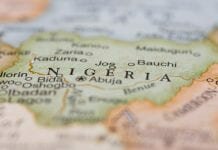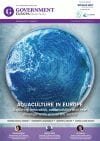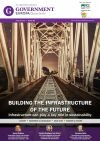
Tony Smith, chairman of the International Border Management and Technologies Association, explains the problem of border control after Brexit.
At the time of writing, there is still uncertainty as to whether the EU Withdrawal Agreement will pass into UK law. The House of Commons is divided between those that want a second referendum (in the hope of a remain vote this time); those that want a more complete break from the EU (including leaving the Customs Union altogether and removing the so called backstop, protecting Irish border control after Brexit); and those that support the current deal.
The latter category is a long way short of the majority it needs; and, worse still, a gap has opened between the position of the Democratic Unionist Party (DUP) and the ruling Conservative Party over the position of Northern Ireland. This threatens the survival of the UK government itself. The political landscape is further complicated by the fact that the Northern Ireland Executive collapsed in January 2017 and has not yet been restored.
At the heart of the problem lies the Irish border, and what to do about it. Nobody wants border control after Brexit on the island of Ireland. The Belfast (Good Friday) Agreement 1998 – promoting North South co-operation – finally ended the troubles over political jurisdiction in Northern Ireland. And it has preserved peace there for two decades.
Much of the Brexit debate hinges around border control. The EU philosophy is that the single market and border control cannot go hand in hand. Freedom of movement of goods, people, services and capital are fundamental, and cannot be cherry picked by third countries.
However, the interpretation of border control varies between countries; especially the UK and Ireland, where separate arrangements were in place long before the creation of the single market.
History and geography play a role in the debate over border control after Brexit
Land borders are much harder to control than maritime borders or air borders. Conveniently, the British Isles do not have the same extensive land borders as those that exist in mainland Europe – only the 310-mile border that divides Ireland from the UK. Both the UK and Ireland chose to opt out of the Schengen Acquis, which effectively removed physical border controls between those countries within it.
Upon arrival by sea or air at either a UK or Irish port of entry from another country outside the UK (including an EU country), all passengers pass through a physical border control and are required to present their passports for inspection. EU nationals pass through separate channels to third country nationals; they may use their national identity cards to enter in lieu of a passport; and (if they hold an electronic passport) they may also enter via an e-gate. So, in that respect, EU passport holders arriving at the UK border are treated in the same way as UK and Irish passport holders, whereas third country nationals need to meet the requirements of the immigration rules – regardless of their status in another member state – and may be refused entry if they do not. This is in stark contrast to travellers moving around the Schengen zone, who don’t go through any form of passport control at all – regardless of their nationality or immigration status.
Exemption from the Schengen Acquis affords both the UK and Ireland significant benefits in terms of immigration control. The migrant crisis in 2015 sent the Schengen group into turmoil as national immigration policies clashed with EU policies on free movement. Governments came under pressure to introduce internal border checks within the Schengen zone that has not existed previously; and the brunt of the crisis was borne by those countries facing an external frontier, such as Greece and Italy. By retaining border controls between themselves and the rest of the EU, the UK and Ireland were able to avoid the brunt of the crisis.
Movement of people in the Brexit debate
Despite this, not much has been said or written about the movement of people in the Brexit debate. The focus of debate – and disagreement – has been over the movement of goods. Why so? This is in part because both the UK and Ireland already sit outside the Schengen zone, so border control after Brexit can theoretically remain largely unaltered; and a little-known agreement called the Common Travel Area (CTA) which extends to the UK, Ireland and the Channel Islands.
In practical terms, the CTA could be described as a smaller version of the Schengen agreement. It was developed to ensure that British and Irish citizens – and citizens of the Channel Isles – could travel freely between their respective countries upon creation of the Irish free state in 1923.
Like Schengen, the CTA has had its share of problems. Most immigration into the Republic of Ireland emanates from the UK; and some commentators see Ireland as a back door for immigration into the UK. Also, at the height of the Troubles, security checks were introduced on routes between the Republic of Ireland and the UK ports to disrupt and deter terrorist travel within the CTA.
Nonetheless the CTA still offers a workable solution for UK-Irish border control after Brexit. Passengers entering the UK from the Republic of Ireland do so under the terms of the Immigration (Control of Entry via Ireland) Order 1972, as amended. This was passed in 1973 when the UK Immigration Act 1971 came into force – and has stood the test of time. There are no immigration controls on passengers arriving in the UK from Ireland. British and Irish passport holders may move freely within the CTA, and this will remain so after Brexit. Third country nationals lawfully entering the UK via Ireland are deemed to be given leave to enter the UK for a limited period, without needing any additional permission from an officer.
So, in the event of freedom of movement coming to an end, EU passport holders could also be deemed to be given leave to enter the UK via Ireland. Yes, there is provision to examine people who are not lawfully in Ireland, but these checks do not need to be conducted at the border itself. If the Irish government and Brussels accept a similar arrangement for passengers travelling into Ireland from the UK, then there is no need for any passport controls between the UK and Ireland; and the dilemma of border control after Brexit can be resolved.
But the difficulty with customs checks remains. As with Schengen, the CTA concerns the movement of people and not the movement of goods. The elimination of customs posts on the Irish border – and at other UK ports for that matter – was entirely contingent upon both countries’ membership of the single market and the EU Customs Union.
The answer may lie with technology. Customs declarations are now processed electronically away from the border; and compliance can be assured via interventions at locations well away from physical border control after Brexit. With trust and goodwill on both sides of the border, anything is possible.
The preservation of the CTA coupled with an imaginative approach to customs controls will not eliminate border control after Brexit altogether. However, it will take us one step closer towards an invisible border, and a potential solution to the current impasse.
Let’s hope a solution is nigh; but let’s not underestimate the scale of the challenge either.
This article is accurate at the time of writing: 12th December 2018
Tony Smith
Chairman
International Border Management and Technologies Association (IBMATA)


















